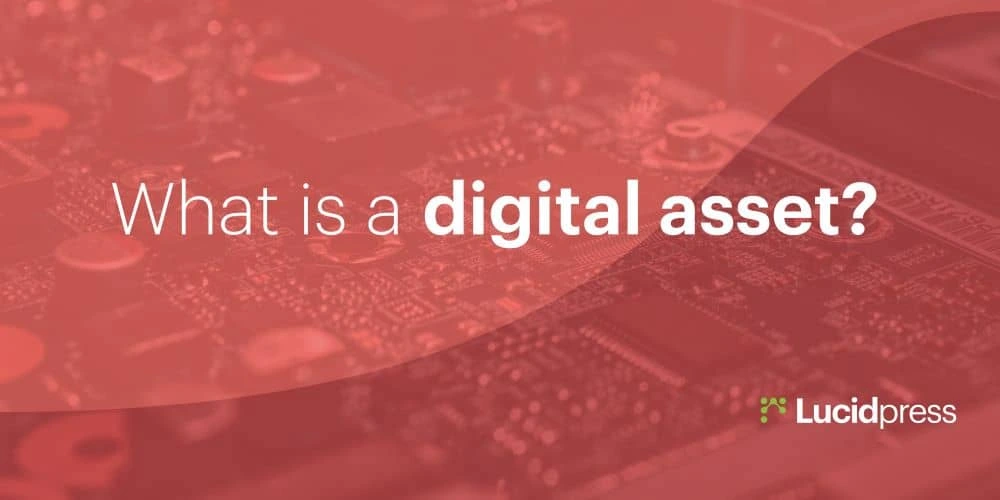Our world has become a digital one. You see its digital fingerprints in virtually every aspect of 21st-century life. We stream movies & shows on smartphones, store photos & documents in the cloud, and create apps to cover a wide spectrum of activities. These digital assets are everywhere.
Related: What is marketing asset management?
For a company, a digital asset creates or augments its brand identity. Understanding the role that a digital asset plays in your success is crucial when you’re managing or marketing a brand.
Identifying a digital asset
What is a digital asset in simple terms? At a basic level, a digital asset is content that’s stored digitally and holds value to the company who uses it.
This creates a broad spectrum of items that can be considered a digital asset. Photos, videos, images, slideshows, graphics, PDFs, spreadsheets, audio files, and even plain text documents all fall under the digital asset umbrella. For example, an .SVG file of your brand logo is a digital asset. So is the template for company letterhead. Advances in technology mean that what is considered a digital asset is always evolving.
For your company, digital assets are going to include everything related to your brand messaging, products offered, and services rendered. If you have digital content that is uniquely identifiable and provides value to your company, it’s considered a digital asset.
Benefits of a digital asset
Companies count on digital assets to serve a couple of distinct purposes. Such assets help build brand awareness. They can also influence a consumer’s purchasing behavior. When used effectively, digital assets can help brands do a better job of engaging consumers and earning their business by offering personalized, relevant content that fits their needs.
Think about it. Would you sell baby clothes & toys to a single person without any children? No. You would target parents with your products. Tailoring digital assets to fit the needs of your target audience sets successful brands apart from brands that fail.
What makes digital content so important? The rise of social media has put a premium on visual content. When you check out platforms like Instagram, Facebook, Twitter and Pinterest, you’ll notice a flood of visual posts featuring photos, short videos and GIFs designed to draw attention. These assets help brands connect with an audience via multiple channels and form the foundation of your brand identity.
How should you manage digital assets?
Making a good first impression and a lasting impression are both equally important in business. You want to manage digital files properly so you can always put your best foot forward in marketing and in communications, with vendors and customers alike.
Before the digital age, managing brand assets meant keeping file cabinets stuffed with all sorts of materials around the office. It could easily get cumbersome and hard to track. Today, digital asset management (DAM) software takes the place of the file cabinet. It makes it easier to store, edit, share and protect your content. Employees can play an active, collaborative role in modifying and sharing documents, images and other digital media while remaining true to your company’s brand voice.
DAM software exists for the purpose of making all digital assets identifiable, searchable and discoverable. It incorporates metadata into the process, which is data — such as keywords or phrases — used to describe a particular digital asset. This makes it easier for your company to build a consistent and strong brand voice across all marketing channels.
Take a holistic approach to digital assets
As a solitary tool, DAM software will not be completely effective in keeping your brand voice loud, strong and memorable. Think of it in terms of owning a car. Getting an occasional oil change isn’t the only thing you do to keep the engine running. You need to fill up other fluids, replace air filters, and do diagnostic checks to extend the life of your car.
Managing digital assets operates on a similar principle. You need to incorporate DAM software into a larger toolbox you use to create and share content. DAM software can be fully integrated to aid other functions such as web content management or digital advertising platforms. It can also be specialized to focus on a narrower channel like media production or brand management.
DAM software does come up short in key areas. It has no version control, no enforced brand guidelines, and no locked templates. The end result is chaos in systems where there should be order in building & maintaining a strong brand voice.
Lucidpress can pick up where DAM software leaves off. It lets you design templates with the latest logos, colors & other assets that align with your brand. You can update brand assets seamlessly and finally get old logos out of circulation. With our brand templating platform, you can create everything from newsletters to social media ads through cloud-based software and a user-friendly interface that promotes real-time collaboration.



